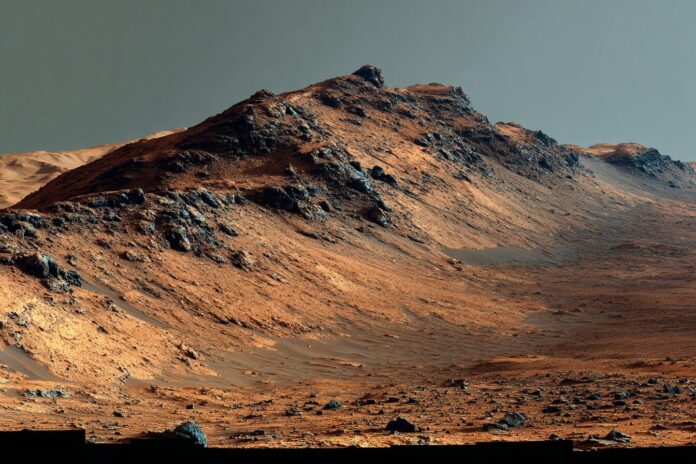The Mars rover Curiosity continues to astound scientists and enthusiasts alike with its recent imaging campaign covering Sols 4638 to 4640. Most importantly, the rover has captured an array of breathtaking views from atop a Martian ridge in Gale Crater. Because the atmospheric conditions were unusually clear, Curiosity was able to document both sweeping panoramas and detailed scientific observations. Therefore, these images not only serve an aesthetic purpose but also provide critical data about Martian geology and environmental conditions.In addition, the mission team has extended the rover’s investigation period at this location. This deliberate pause ensures that a wealth of data is collected under optimal conditions. Besides that, the campaign is an inspirational example of modern extraterrestrial exploration and precision engineering.
A Ridge with a View: Unveiling the Martian Landscape
Curiosity’s present position on the edge of a pronounced ridge provides an unparalleled vantage point. The site allows instruments like Mastcam and ChemCam to capture extensive mosaics and high-resolution images. Most importantly, the large Mastcam mosaic, assembled from 44 individual images, meticulously documents the north crater rim.Because the atmospheric dust was at a minimum, every detail was recorded with exceptional clarity. The images reveal diverse textures and color gradations, offering insights into Mars’ geological past. Therefore, this imaging effort is crucial for understanding both the present and past dynamics of the Martian landscape.
Boxwork Structures: A Close-Up on Martian Geology
The focus then shifts to the intriguing boxwork structures observed near the rover’s position. These delicate, net-like rock formations are essential for interpreting Mars’ erosional and weathering processes. Most importantly, such detailed imagery allows scientists to assess mineral compositions and the history of water exposure on Mars.Because the imaging campaign targeted these geological marvels, every shot contributes to a deeper understanding of Martian rock mechanics. Furthermore, Curiosity captured high-quality images of the ChemCam AEGIS target and continued to document the striking “Mishe Mokwa” butte. Therefore, the campaign serves as a dual exploration of both broad landscapes and microscopic geological features.
Planning for the Future: Documenting Distant Outcrops
ChemCam’s Remote Micro-Imager (RMI) played a pivotal role by capturing detailed images of distant outcrops, like the feature nicknamed “Dragones.” Most importantly, these images pave the way for planning future traverses as the rover slowly approaches new targets. The detailed imaging ensures that upcoming paths are chosen with precision.Because advanced planning is essential for successful exploration, the team used these photographs to refine navigation strategies. In addition, the clear and structured views assist in prioritizing subsequent scientific observations. Therefore, every captured detail directly influences mission planning and future exploration tactics.
Mars’ Atmosphere in Focus
The imaging effort was further enriched by a suite of atmospheric observations. Curiosity’s Navcams captured dust-devil movies and dust surveys that display dynamic weather patterns. Most importantly, five cloud movies were recorded, offering live insights into modern Martian meteorology.Because atmospheric clarity is vital, additional observations such as line-of-sight views of the crater rim and Mastcam tau measurements were also obtained. Furthermore, these atmospheric readings are critical for both ongoing scientific research and for planning future missions. Therefore, they form an integral part of the rover’s comprehensive investigation.
Continuing the Investigation
Despite the extensive imaging and data collection, the team decided to keep Curiosity in the area for additional studies. The rover only moved approximately 2 meters in its latest drive, ensuring it remained strategically positioned for further exploration. Most importantly, this careful maneuvering allows the capture of even more detailed observations over time.Because further data is essential to fully understand the Martian environment, Curiosity will continue to document geological and atmospheric phenomena. In addition, the prolonged stay guarantees that any subtle environmental changes are recorded. Therefore, a wealth of scientific insights is anticipated in the coming months.
Why Imaging Matters on Mars
Imaging is far more than capturing stunning visuals; it is a critical scientific tool. Most importantly, each mosaic and close-up provides invaluable data to help reconstruct Mars’ climatic, geological, and possibly biological history. Because every detail matters, images of features such as the boxwork structures offer insights into mineral formation and erosion history.Besides that, broader panoramas help contextualize these details within the larger Martian landscape. This integrated approach assists researchers in piecing together the environmental forces that shaped the Red Planet over billions of years. Therefore, the imagery not only beautifies our perception of Mars but builds a foundation for scientific breakthroughs.
Integrating Modern Science and Future Missions
The rich dataset from Curiosity’s latest imaging campaign enhances our understanding of Mars and directs future exploration strategies. Most importantly, these findings will influence both robotic and human missions under NASA’s Moon to Mars initiative. Because each image serves as a scientific milestone, the repository of Mars imagery will inspire continued innovation and exploration.Furthermore, integrating these observations with models and simulations available on platforms like GeoBlogosphere offers an interdisciplinary perspective. Besides that, related video updates on YouTube provide dynamic visualizations that complement the static imagery. Therefore, these diverse data sources collectively prepare us for future endeavors on the Red Planet.
References and Further Exploration
For further details on Curiosity’s imaging campaign and its ongoing mission, you can explore several dedicated resources. Most importantly, the official NASA Science Blog provides in-depth coverage and updates on the mission’s progress. Because staying informed is key, additional perspectives are offered by external mirrors such as the Ghost NASA Mirror.In addition, immersive visual experiences like the NASA/JPL 360-View Video and detailed Mastcam imagery available on YouTube further enhance public understanding of the mission’s achievements. Therefore, these engaging multimedia elements are ideal for both academic research and public outreach.



